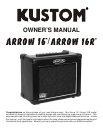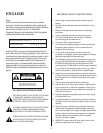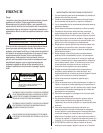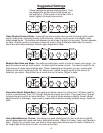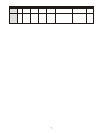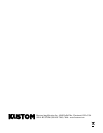
1.) CD/Tape Input - This 1/4" 3-conductor jack will allow you to plug in a CD player, tape or any other
source to practice along with. It sums the left and right signals into a mono signal and passes it through
to the amplifier section. To control the volume of the source, adjust the output volume of the device. We
suggest you turn the volume all the way down then plug in and adjust the volume according to your
taste.
2.) Guitar Input - This is a 1/4" 2-conductor input jack for plugging in your instrument. It is intended for
guitars but will accept other instruments as well.
3.) Lead Gain - Adjust this clockwise to increase the amount of distortion you add to the overdrive signal.
Used in the lower ranges of the control you will get a less distorted sound. As you increase the gain, you
add tremendous amounts of distortion to the signal for a harder edged "crunch" tone.
4.) Channel Select Switch - This switch selects which preamp you are using. It will switch between the
Clean and Lead channels.
5.) Lead Volume - This control is the output volume control for the Lead Channel. It follows the same tone
circuit as the other channel. Its gain structure is determined by the lead gain control but this serves as
the overall master volume for this channel.
6.) Clean Level - This is the volume control for the clean channel. Its gain structure is preset for maximum
signal before distortion and determines the output level of the amp.
7.) Bass - This control is the bass control. It is passive and set to shelve frequencies at 100 Hz. This will
affect the low frequency signals. Turning it fully clockwise, the signal is left alone. Turning it
counterclockwise, the lows will be rolled off.
8.) Mid - This control is the midrange control. It is passive and set to shelve frequencies at 700 Hz. This will
affect the middle frequency signals. Turning it counterclockwise, your signal will "hollow out" the mid
frequency, which is popular in today's music.
9.) High - This control is the high control. It is passive and set to shelve frequencies at 4KHz. This will effect
the high frequency signals. Turning it fully clockwise, the signal is left alone. Turning it counterclockwise,
the highs will be rolled off.
10.) Reverb Level - (only on the Arrow16R). This control adds the spring reverb and mixes it into the main
signal buss. Reverberation lets the notes "hang in the air" longer, extending the sound.
11.) Headphone Jack - This is a 1/4" 3-conductor jack for plugging headphones. It will sum the signal and
put the sound in both ears, thereby creating a pseudo-stereo sound. Volume will be determined by the
volume control on the channel you are on. It will disconnect the internal speaker when plugged into. This
will allow quiet practicing.
12.) Jewel Light - This jewel light lets you know that the amplifier is on.
13.) Power - This switch turns on and off the AC power to the amp.
Back Panel (not pictured) -
Speaker Out - This is a 2-conductor 1/4" speaker output jack. This will disconnect the internal speaker
and allow an external speaker cabinet to be employed. Rating is 8 ohms.
5



